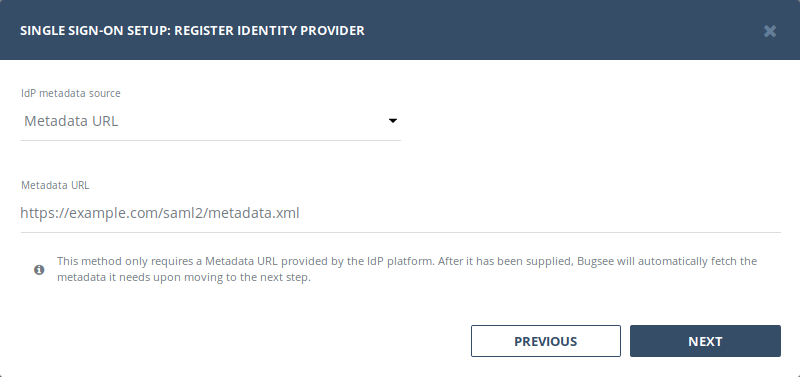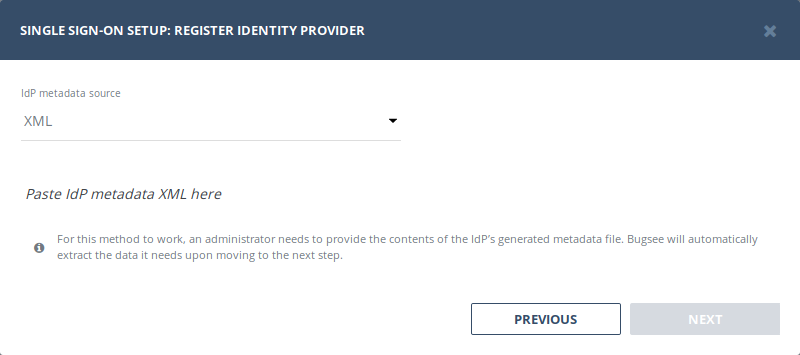Single Sign-On
Bugsee provides a generic auth provider for SAML2 based authentication, which allows Admins of a Bugsee organization to manually configure any SAML2-enabled IdP system. Below are the general steps for integration.
Setup
Bugsee supports the following SAML services:
Identity and Service Provider initiated SSO Identity Provider initiated SLO (Single Logout)
1. Register Bugsee with IdP
Before connecting Bugsee to the Identity Provider (IdP), it’s important to first register Bugsee as an application on the IdP’s side. Bugsee's SAML endpoints are as follows, where the {organization_id} is substituted for your organization ID:
Entity ID:
https://app.bugsee.com/{organization_id}
ACS:
https://api.bugsee.com/v2/auth/saml/acs/{organization_id}
SLS:
https://api.bugsee.com/v2/auth/saml/sls/{organization_id}
Single Sign On URL:
https://app.bugsee.com/#/signin?sso_target={organization_id}
Metadata:
https://api.bugsee.com/v2/auth/saml/metadata/{organization_id}
2. Register IdP with Bugsee
There are two methods for registering your IdP with Bugsee: Metadata and XML. Each method is described below and will produce the same end result.
Using Metadata URL
This method only requires a Metadata URL provided by the IdP platform. After it has been supplied, Bugsee will automatically fetch the metadata it needs.

Using Provider XML
For this method to work, an administrator needs to provide the contents of the IdP’s generated metadata file. Once the contents are pasted directly into the text field, Bugsee will do the rest.

Here’s an example of what the Metadata XML contents look like.
<?xml version="1.0" encoding="UTF-8"?>
<EntityDescriptor xmlns="urn:oasis:names:tc:SAML:2.0:metadata" ID="00000000-0000-0000-0000-272f3f1b048d" entityID="https://sts.windows.net/00000000-0000-0000-0000-53fb3b9ed0e3/">
<IDPSSODescriptor protocolSupportEnumeration="urn:oasis:names:tc:SAML:2.0:protocol">
<KeyDescriptor use="signing">
<KeyInfo xmlns="http://www.w3.org/2000/09/xmldsig#">
<X509Data>
<X509Certificate>...</X509Certificate>
</X509Data>
</KeyInfo>
</KeyDescriptor>
<SingleLogoutService Binding="urn:oasis:names:tc:SAML:2.0:bindings:HTTP-Redirect" Location="https://login.microsoftonline.com/00000000-0000-0000-0000-53fb3b9ed0e3/saml2" />
<SingleSignOnService Binding="urn:oasis:names:tc:SAML:2.0:bindings:HTTP-Redirect" Location="https://login.microsoftonline.com/00000000-0000-0000-0000-53fb3b9ed0e3/saml2" />
<SingleSignOnService Binding="urn:oasis:names:tc:SAML:2.0:bindings:HTTP-POST" Location="https://login.microsoftonline.com/00000000-0000-0000-a484-53fb3b9ed0e3/saml2" />
</IDPSSODescriptor>
</EntityDescriptor>
3. Map IdP Attributes
Here, the field values of Bugsee members need to be matched up with the corresponding values for members in the IdP. The basic required fields are the IdP’s User ID and email address, but Bugsee can also optionally pull name and admin flag values from there as well.

4. Complete and save SSO configuration

Once the SAML integration flow is complete, the related section in Company settings page will reflect the status of a successful integration.

Bugsee uses Just-In-Time (JIT) provisioning, thus new members are registered with Bugsee automatically during their first login attempt with SAML SSO. These accounts will have their membership type set to User and will not have access to any app by default. Admins in your organization will have to grant each user access to the appropriate applications within Bugsee.
